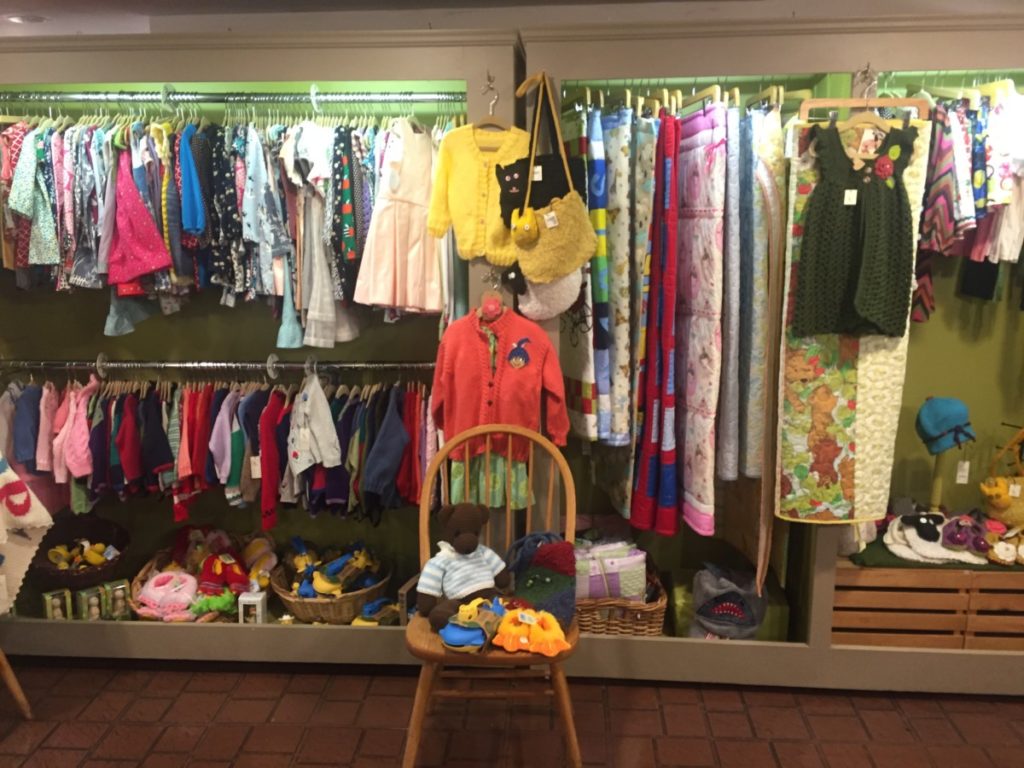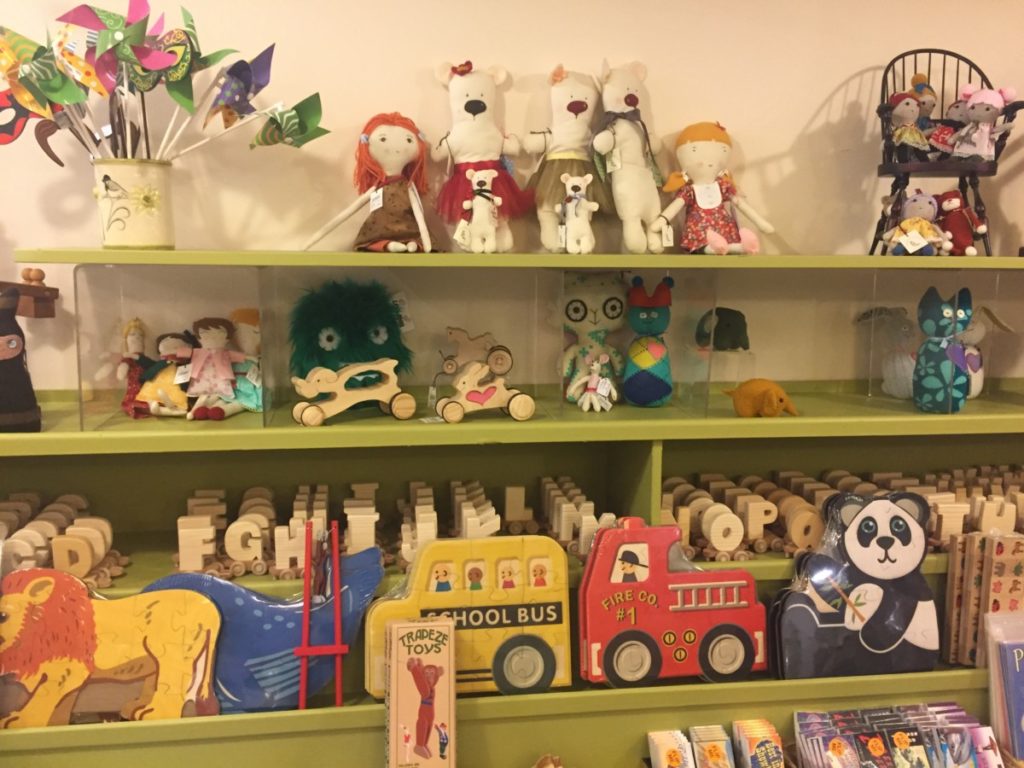In a span of two years, Judith Correa went from unemployed, to selling handmade baby clothes, to owning her own shop. In a matter of months, Tony Okerson went from dealing with his father’s death, to learning how to make wooden name trains, to growing his dad’s business.
Behind these stories is the Brooklyn Women’s Exchange, a small volunteer-run store in Brooklyn Heights. The shop sells handmade goods from craftspeople, and returns 70 percent of the final sale of an item to the artisan. “We’re Etsy before Etsy,” Elizabeth Betteil, the store’s manager says.
The shop is part of the Federation of Woman’s Exchanges, which once operated nearly 200 stores across the United States. Today, only 20 remain. But the Brooklyn Women’s Exchange, a staple of the community for over 160 years, has survived, by adapting to the times and making some smart investments. But the unsung heroes are the passionate craftspeople like Correa, who contribute to the store simply out of passion and commitment.
“We do it for the love,” Correa says. “To see something pretty. That’s what gets us by. It’s what keeps us busy.”
When Correa began making baby clothes for the Brooklyn Women’s Exchange in 1994, she didn’t just do it for fun. She had a serious issue. Correa worked an office job that year and had been laid off, leaving her scrambling for work. For weeks, she searched and searched, but could not find anything. Then one day, she found out about the Brooklyn Women’s Exchange through her sister, who was working at a medical office where she knew a doctor who was married to a volunteer of the shop.

Sewing has always been a passion for Correa, but she never thought it would become a career. Two related incidents changed that. First, in 1993, Correa tripped down the stairs in her building and hurt her ankle. A couple of years later, she won a settlement for the accident. In those two years, Correa had started sewing, built a vast clientele and had even saved up some money from selling her clothes to the Brooklyn Women’s Exchange.
Thanks to the money she obtained from the settlement, some financial help from her sisters, and the reputation she had built with her clients, Correa had saved the $7,000 she needed to open her own shop, Judy’s Fancies, on 49th Street in Manhattan. However, Correa had to close down the shop after three years, as her landlord intended on doubling her rent.
Even after a rent increase forced Correa to close her shop, Correa remains undaunted. She continues to make clothes for the Brooklyn Women’s Exchange. Her income might vary, as low as $50, as high as $400, but in some ways, the money is secondary. “It makes me feel like I’ve spread a little bit of me out there,” she says.
It’s the little things that keep Correa going. Like her clients, who pass on their baby clothes to their kids and then to their grandkids.“I’ve seen those children grow, I’ve seen them have siblings, and it’s amazing,” Correa says, “because I still get Christmas cards from them no matter where they are.”
Like Correa, Okerson has a more meaningful reason to sell his items. In 1992, Okerson’s father passed away. His dad made wooden name trains and sold them to many crafts stores, including the Memphis Women’s Exchange. “I really had no intention of making wooden toys,” Okerson says, “but when dad passed away, his customers wanted to know if someone else was going to take it over, so I decided well I’d give it a shot.”
Now Okerson sells his work to nine of the 20 Exchanges and to several crafts stores. His business is his main source of income, but like Correa, he’s driven by something more than money. His father’s memory is what pushes him along with “the satisfaction of knowing that a lot of people enjoy it what I do,” he says.

The customers aren’t the only ones who enjoy the items at the Brooklyn Women’s Exchange. “This is the happiest job I’ve ever had in my entire life,” Elizabeth Betteil, the store manager, says. “I get to open boxes by creative people that have cute things, and it just makes me happy.”
Betteil oversees the day-to-day operations of the shop, and works with volunteers to decide what the store needs. The shop sells goods ranging from baby clothes, to house items, to jewelry. Entering the store means immersing oneself in a sea of colors. Shelves are full of dolls, stuffed animals, and toys, all handmade.
The shop has almost 40 volunteers, who are required to work two shifts in a month for a total of 10 hours. The store has been lucky to have many volunteers, Anne Donovan, the Exchange’s president says, but their dedication to the store has been of utmost importance. “This isn’t a social outlet for us, even though it’s very friendly,” Donovan says. “We don’t gather here to visit. We come here and we work.”
The Brooklyn Women’s Exchange opened in 1854 as a haven for women to sell their crafts anonymously. Women who sewed and knitted sent their items to the shop, and received 70 percent of the final sale of an item, a business model the shop still employs. Today, the store accepts crafts from both men and women in an effort to “further American crafts movement,” the shop’s website states.
The shop in Brooklyn is one of two Exchange stores that remain in New York State, and the only one left in New York City. In 2003, the Manhattan Women’s Exchange closed down because of rising rent costs, according to Martha Foley, the Brooklyn shop’s archivist. The store in Brooklyn Heights has been in several locations in the neighborhood since its inception, but moved to its current spot at 55 Pierrepont Street in 1978. The shop has also benefited from the generous contributions it has received from its landlord, the Catholic Charities organization, which rents out its locations to nonprofits. “If we had to pay commercial real estate, I don’t think this shop would exist,” Foley says.
The store has taken advantage of its privileged financial position. The 30 percent of the final sale of an item that the shop keeps is used to buy manufactured goods and reinvest in the store. Manufactured goods make up nearly 40 percent of the items sold at the shop.
But the store has also taken advantage of its convenient location. “I think the fact that Brooklyn has become a popular destination for tourists has bolstered our business,” Donovan says.
The Brooklyn Women’s Exchange faces a tough challenge, as it tries to replicate its success and avoid being one of the hundreds of Exchanges that have closed down. But Donovan believes the shop will keep on attracting craftspeople. “The idea of having their merchandise in a brick and mortar store where people can touch and feel things … that is a great advantage,” Donovan says.
It is hard to believe that the shop, with craftspeople like Correa and Okerson, who contribute to it out of love, will go out of business anytime soon.


Leave a Reply